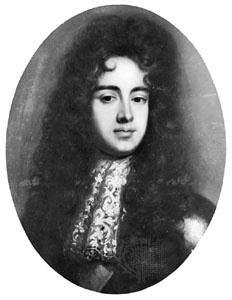Monmouth, James Scott, Duke of, Duke Of Buccleuch, Earl Of Doncaster, Earl Of Dalkeith, Baron Scott Of Tindale, Lord Scott Of Whitchester And Eskdale
English noble
byname (until 1663) James Fitzroy, or Crofts
born April 9, 1649, Rotterdam, Neth.
died July 15, 1685, London, Eng.
 claimant to the English throne who led an unsuccessful rebellion against King James II in 1685. Although the strikingly handsome Monmouth had the outward bearing of an ideal monarch, he lacked the intelligence and resolution needed for a determined struggle for power.
claimant to the English throne who led an unsuccessful rebellion against King James II in 1685. Although the strikingly handsome Monmouth had the outward bearing of an ideal monarch, he lacked the intelligence and resolution needed for a determined struggle for power.Monmouth was the illegitimate son of King Charles II and Lucy Walter. Banished from England because she claimed to be the king's wife, Lucy settled with young James in Paris. In 1662 James was brought to England and installed at court as a favourite of the king, who on Feb. 14, 1663, created him Duke of Monmouth, Earl of Doncaster, and Baron Scott of Tindale and made him a Knight of the Garter. On April 20, Monmouth was married to the wealthy Scottish heiress Anne Scott, Countess of Buccleuch; they were created Duke and Duchess of Buccleuch, and he took the surname of Scott. Even at this early date some Englishmen viewed him as a possible successor to Charles. Since Monmouth was a Protestant, his political opportunities increased when Charles's brother and acknowledged heir, James, Duke of York, converted to Roman Catholicism about 1668.
Monmouth was made captain of the king's guard in 1668 and admitted to the privy council in 1670. During the Anglo-Dutch War of 1672–74, he commanded English troops on the European continent. He became captain general of all the armed forces in England in 1678, and on June 22, 1679, he triumphed over the Scottish Presbyterian rebels at Bothwell Bridge, Lanark. Meanwhile, the succession to the throne had become a burning issue in England, where antipapal hysteria had been aroused by rumours that the Catholics were plotting to seize power. Charles blocked all parliamentary attempts to exclude James from the royal inheritance, and in September 1679 he banished Monmouth from the kingdom. Nevertheless, the duke quickly returned in defiance of his father and set about building up a following. In this crisis Monmouth was championed for the succession by Anthony Ashley Cooper, Earl of Shaftesbury, the leader of the anti-Catholic Whigs in Parliament. In 1682–83 Monmouth became involved in the Whig conspiracy against Charles and James, known as the Rye House Plot. Although pardoned for his part in this enterprise, he was banished from court and took refuge in the Netherlands early in 1684.
Upon the death of Charles II on Feb. 6, 1685, the Duke of York acceded to power as James II. Monmouth landed at Lyme Regis, Dorset, with 82 followers in June and quickly raised over 4,000 men, but he was unable to rally the gentry to his rebellion. On July 6 his army of peasantry was totally defeated on the plain of Sedgemoor, Somerset. He fled but was soon captured and beheaded.
Additional Reading
Monmouth's life is recounted in Bryan Bevan, James, Duke of Monmouth (1973); and his rebellion in Peter Earle, Monmouth's Rebels (1977).
- Ramón María Narváez, duque de Valencia
- Ramón Menéndez Pidal
- Ramón Pérez de Ayala
- Ramón y Cajal, Santiago
- Ramādī, Al-
- Rana
- Ranade, Mahadev Govind
- Ranaivo, Flavien
- Rana Pratāp Singh
- Rancagua
- Rance River
- ranch
- ranch house
- Ranchi
- Rancho Cucamonga
- rancidity
- Rancé, Armand-Jean Le Bouthillier de
- rand
- Randall Jarrell
- Randall, John Herman, Jr.
- Randall-MacIver, David
- Randall, Samuel J(ackson)
- Randall Thomas Davidson, Baron Davidson
- Randall Thomas Davidson Davidson, Baron
- Randall Thompson